|
|
 Director's Letter Director's Letter
 | |
In the past few years we've brought several singular masterpieces to the DIA: Vermeer's Woman Holding a Balance in 2012, Van Gogh's Artist's Room at Arles and Caravaggio's Saint Francis of Assisi in Ecstasy, both in 2013, and most recently Monet's Waterlily Pond, Green Harmony from the Musée d'Orsay, Paris. In each case, the special loan cast a spotlight on different aspects of our own collection. We certainly have one of the finest collections of Dutch art in the Western Hemisphere but it lacks--and, I fear, always will--a work by Vermeer. Where William Valentiner, the ubiquitous DIA director, was when Vermeer's The Art of Painting was briefly in this country, I don't know, but there seems to be no evidence suggesting that he knew about it. And, as he agonizes at length in his personal diary about not being able to secure a mature Velasquez, it's hard to believe he wouldn't have mentioned a Vermeer. I have to admit to a distinct feeling of schadenfreude that the New York art museum to which it was offered turned it down, and it can now be seen in Vienna's Kunsthistorisches Museum. The National Gallery of Art generously lent Woman Holding a Balance for a month, which we were able to exhibit within the suite of galleries dedicated to Dutch art. The two 2013 loans came about as exchanges to compensate for the loan of two much-requested works: our own Caravaggio painting, Martha and Mary Magdalene, and Picasso's Melancholy Woman.
The recently departed Monet complemented our lone Monet painting, Gladioli, of 1876, which shows his wife, Camille, walking through their garden. Monet was a great gardener, and even when he was struggling financially (as was the case in the mid-1870s), he managed to maintain a garden. If you have to have just one Monet, Gladioli, is a great one to have, sparkling with the genius that overturned four hundred years of artistic verities. But it's a little lonely in our early modern galleries dominated, as they are, by such non-impressionists and post-impressionists as Degas, Cézanne, and van Gogh. As I never tire of pointing out, led by patrons such as Ralph Harmon Booth and Dexter Ferry, as well as soon-to-be director, William Valentiner, in 1922 the DIA was the first public museum in the United States to acquire a van Gogh, followed by the first Matisse in the same year. These were astonishingly forward-looking acquisitions that speak volumes about the confidence and sophistication of 1920s Detroit. In justifying the Matisse, Valentiner wrote to the City of Detroit Arts Commission that, although the painting would strike many as odd, Detroit needed to know what was going on at the center of the art world. In the same spirit, in 1930, the first DIA auxiliary support group, the Friends of Modern Art, was established, fostering an environment in which a 1952 Francis Bacon painting, "hot off the easel," was eagerly accepted as a gift from William Valentiner after the museum he was then running in Los Angeles (City of Detroit mandatory retirement had forced him out of the DIA in 1945) rejected it.
Why, then, the paucity of high impressionist paintings in the DIA's collection? I've come across no direct comments by Valentiner on the subject, but there was a feeling in the art world at the time that, for all its energetic brushwork and visual acuity, impressionism was somehow superficial. Cézanne said of Monet: "He was only an eye, but my God, what an eye!" and younger artists sought to take the breakthrough offered by impressionist technique and use it for notionally more profound purposes--the pseudo-scientific pointillism of Seurat, the visceral expressionism of van Gogh, the symbolism of Gauguin--to express aspects of the human condition. Judged by such standards, Monet's landscapes seemed passé. But Monet himself did not stand still. As is usually the case with the greatest artists, he sought to reinvigorate his quest and set off on a path that would ultimately lead to the exquisite, nearly abstract, essays in color and light that are the late water lily paintings.

Graham W. J. Beal, Director
Detroit Institute of Arts
Back to top |
|

Exhibitions
 Photographs from the Detroit Walk-In Photographs from the Detroit Walk-In
Portrait Studio by Corine Vermeulen
Through May 17, 2015
Desalle Photography Gallery
Dutch-born photographer Corine Vermeulen says she "didn't come to Detroit to witness the end of an era. I just wanted to find out if there was a future and what would it look like." Her conclusion? It's about people like the ones seen in this exhibition.
Vermeulen has been in the United States since 2001, coming to the Detroit area for graduate school. She moved back to the Netherlands in 2004, returning to Detroit in early 2006 and has made her home in the city since then. "I feel like I have culturally assimilated quite a bit, but on the other hand I feel like I'm still always catching up, running behind the facts . . . But I do feel very at home in Detroit and it's become my everyday reality," she says.
As a matter of fact, she adds, "I actually feel quite alienated when I go back to The Netherlands, about once a year now . . . I think it's because in Detroit things are not covered up much, everything is mostly out in the open, a lot of social ills are right there in your face . . . In The Netherlands, it's like a parallel universe to me now, where everything is hyper-organized and urban planned and everything appears to be fine. It is very hard to reconcile these two realities."
Click here to view exhibition-related videos.
Free with museum admission
Above: LaTiece, D-Town Farms, 2013 (printed 2014), pigment print; Corine Vermeulen, Dutch. Courtesy of the artist and the Susanne Hilberry Gallery.
Back to top
 Ordinary People by Extraordinary Artists Ordinary People by Extraordinary Artists
Works on Paper by Degas, Renoir, and Friends
Through March 29, 2015
Schwartz Galleries of Prints and Drawings
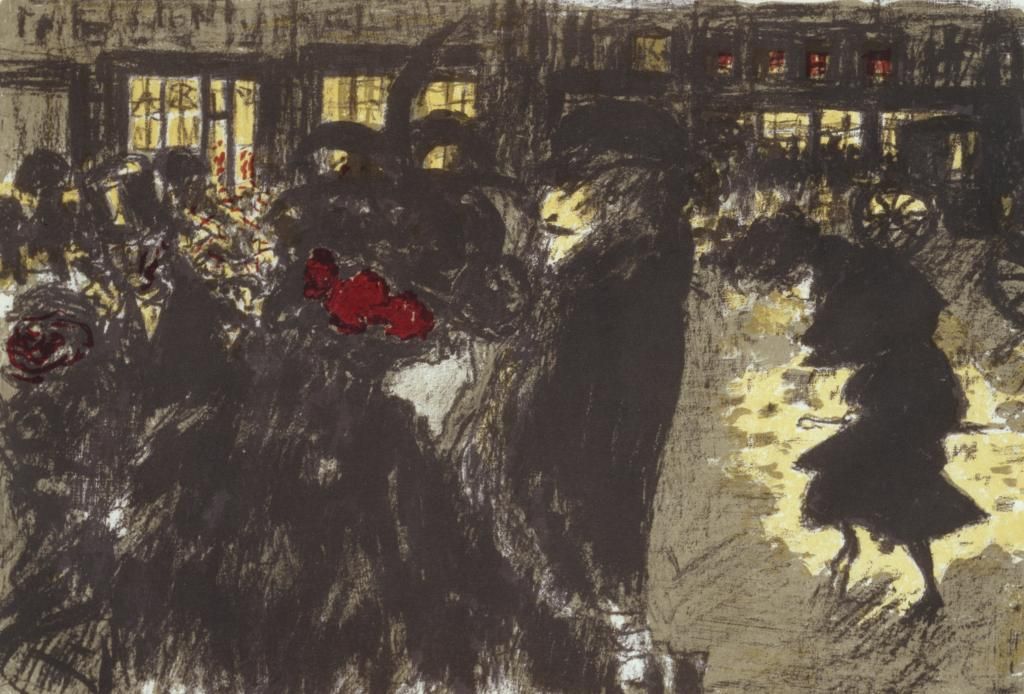 | | |
Square in the Evening, 1899, lithograph; Pierre Bonnard, French. Founders Society Purchase, General Endowment Fund, K. T. Keller Fund
| | 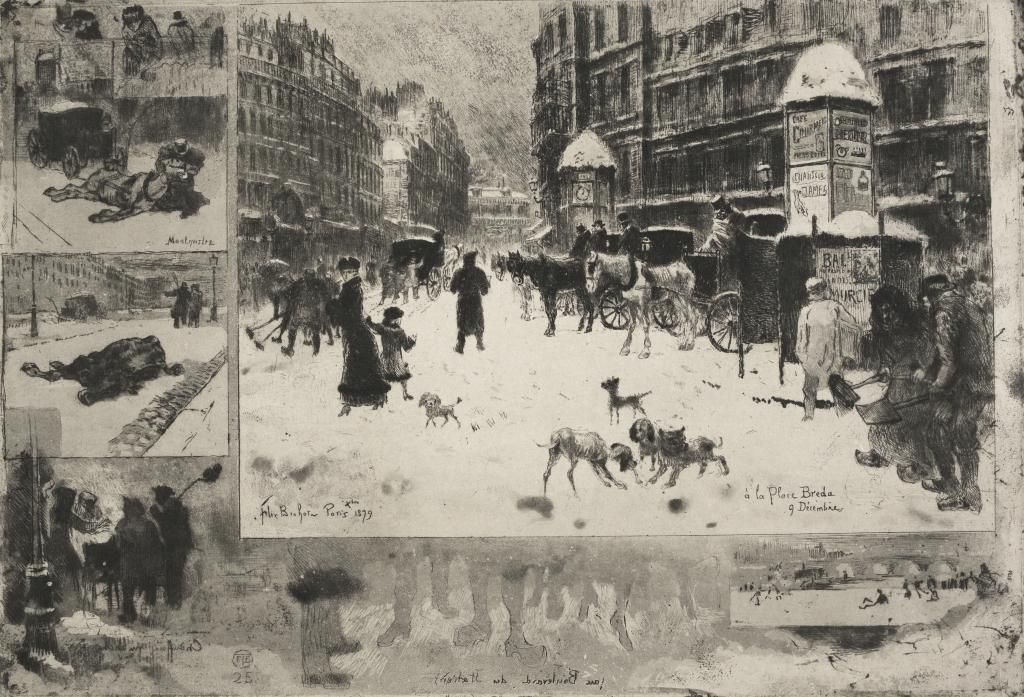 | | |
Winter in Paris, 1879, etching, softground etching, drypoint, aquatint, and roulette; Félix Buhot French. Bequest of Hal H. Smith
| | 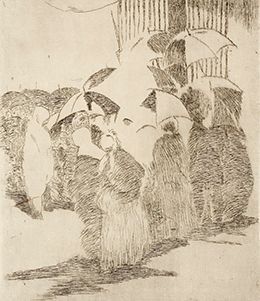 | | |
The Line in Front of the Butcher's Shop, 1870/1871, Etching; Édouard Manet, French. Founders Society Purchase, General Endowment Fund
| |
The artists featured in this exhibition depicted contemporary life in all its many guises--at home, in the countryside, at theaters and nightclubs, on urban streets--but it was the city of Paris itself that was the prime symbol of modernity. In the last quarter of the nineteenth century, Paris was becoming the unparalleled, dynamic art capital of the world with its grand urban setting changing rapidly before the eyes of its citizens from a warren of medieval streets into a grand showplace of wide boulevards and parks.
Pierre Bonnard's and Édouard Vuillard's exceptional achievements in color lithography in the late 1890s celebrated Paris's beauty and vitality. Their style and representations, exemplified in Bonnard's The Square at Evening (upper left) and The Arch of Triumph and Vuillard's The Tuileries, reflect the way they saw their modernizing city--energetic, bustling, and barely capable of holding still.
Felix Buhot experimented with all etching techniques and modified his papers and inks with other substances, such as tea, coffee, and gasoline to create temporal scenes involving special effects of time, season, light, and weather. He is credited with inventing what he called "symphonic margins" developing what was usually the blank wide borders around the print into an adjunct part of the central composition, filled with related designs (see middle left).
Unlike the other artists in this exhibition who avoided political subjects, Édouard Manet did not shy away from gritty and even gruesome aspects of Parisian life during the Prussian siege of the city in 1870 and 1871. He depicted barricaded avenues and the deadly results of street fighting, along with the impact of political events on everyday citizens in a scene of people lined up in the rain hoping to buy meat (lower left).
Guided tours of the exhibition are Tuesday through Friday at noon and Saturday and Sunday at 2 p.m. Free with museum admission.
Back to top |
|
 Detroit Film Theatre Detroit Film Theatre
Potential Oscar® winners begin and end the DFT schedule for January. The Winter 2015 schedule starts off the weekend of January 9 with Force Majeure (left), a sold-out smash at the 2014 Toronto Film Festival and named to the shortlist of contender's for this year's Academy Award Best Foreign Language Film. This wickedly funny and precisely observed psychodrama tells the story of a model Swedish family--handsome businessman Tomas, his willowy wife, Ebba, and their two blond children--on a skiing holiday in the French Alps interrupted by an avalanche.
The month ends with the first screening of the perennially popular Oscar-nominated shorts, in both the animated and live-action categories, on Friday and Saturday, January 30 and 31. The exact films won't be known until the Academy Award® nominations are announced January 15, but audiences can expect three hours of exceptional entertainment. The nominated shorts run through February 19, leaving plenty of time to catch a screening and predict the winners before the statuettes are handed out on February 22. This has become one of the DFT's most popular annual programs; advance tickets are highly recommended.
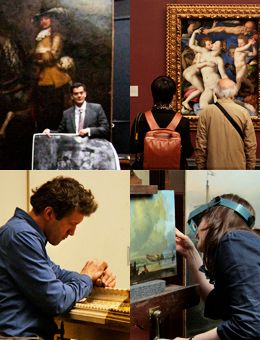 | |
Perhaps America's greatest living documentary filmmaker, Frederick Wiseman has created an exceptional body of work consisting of more than forty films probing how modern human society functions. He introduces his latest film, National Gallery (left), a behind-the-scenes look at a major London museum although the real subjects are color, light, perception, and the wonders of creativity, on Thursday, January 22. After the screening, he discusses his work with film curator Elliot Wilhelm. The film runs through Sunday, January 25.
A special screening of Al Pacino's just-released The Humbling is scheduled for Wednesday, January 28. Adapted from a Philip Roth novel and directed by Barry Levinson, the film is the story of an aged and addled actor (Pacino) whose world is turned upside down after he embarks upon an affair with a lesbian.
For a complete 2015 schedule or to purchase tickets, click here.
|
Presented by
|  |  |
Back to top |
|
 On the Road On the Road
 | | |
Arrangement in Gray: Portrait of the Painter, 1872, oil on canvas; James Abbott McNeill Whistler, American.
Bequest of Henry Glover Stevens in memory of Ellen P. Stevens and Mary M. Stevens
| | 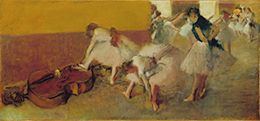 | | |
Dancers in the Green Room, ca. 1879, oil on canvas; Edgar Degas, French. City of Detroit Purchase
| | 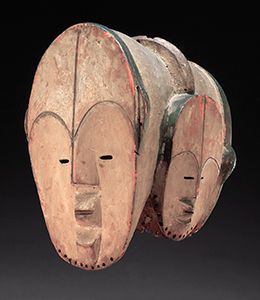 | | |
Mask, 19th century, wood, kaolin; Fang, present day Gabon, Central Africa. Founders Society Purchase, New Endowment Fund, General Endowment Fund, Benson and Edith Ford Fund, Henry Ford II Fund, Conrad H. Smith Fund
| |
Haven't seen one of your favorites in the galleries recently? Quite a number of well-known works from the permanent collection are on loan to museums around the world. Farthest a field is James McNeill Whistler's Arrangement in Gray: Portrait of the Painter, which is part of a Whistler retrospective at the National Museum of Modern Art in Kyoto, Japan, and the Yokohama Museum of Art. It returns to Detroit in March.
Other works from the American art collection that are out and about are George Caleb Bingham's The Trappers' Return, on a three-city tour--Fort Worth, Saint Louis, and New York--with the exhibition Navigating the West: George Caleb Bingham and the River. Traveling to two California museums (San Jose and Laguna Beach) is Robert Henri's The Beach Hat, part of the exhibition California Portraits: Realism, Race, and Region, 1914-1925, which ends in May.
Masterpieces of European painting that are on the road include Max Beckmann's Still Life with Fallen Candles in the Hamburger Kunsthalle in Germany. Paul Cézanne's Three Skulls at the Barnes Foundation (Philadelphia, PA) and the Art Gallery of Hamilton (Hamilton, ON, Canada) and his Madame Cezanne at New York's Metropolitan Museum of Art. Edgar Degas's Dancers in the Green Room is at the Staatliche Kunsthalle in Karlsruhe, Germany. All return to Detroit in March. Two stellar examples of Fang art from Africa--a head and a mask--are part of the exhibition Helena Rubenstein: Beauty Is Power at the Jewish Museum, New York, through March 22.
Loans are a two-way street and Rembrandt's Self-portrait with Shaded Eyes from 1634 is on view in the DIA's third-floor Dutch galleries until the end of 2015. It is a loan from the Leiden Collection in New York.
Back to top |
|
 News and Notes News and Notes
Parking
The upgrades to the museum parking lot across John R from the DIA have been completed. The entrance to the lot is still on John R, but there are now two lanes for getting into the lot, each with an automated pay station. The machines accept credit and debit cards, as well as cash; an attendant is available for anyone needing assistance. Two lanes are available for exiting the lot onto Brush St. A new pedestrian plaza exit brings visitors to Farnsworth, where there is a crosswalk with a traffic light, making crossing busy John R safer.
The fee for parking is now $7 at all times. The increased charge is the first time the price has risen in at least seven years, even though costs to operate the lot have risen. Valet parking, available at the Woodward entrance on Fridays, Saturdays, and Sundays during museum hours, remains $10.
Martin Luther King, JR. Day
The museum is open Monday, January 19, from 9 a.m. to 4 p.m., in celebration of the national holiday honoring Martin Luther King, Jr. A tour of works by African American artists is given four times during the day, every half hour between noon and 1:30 p.m. King: A Filmed Record...Montgomery To Memphis (left) is a monumental documentary that follows King, from 1955 to 1968 and his rise from regional activist to world-renowned leader of the Civil Rights movement. The film is at 2 p.m. There is a drop-in workshop as well. Events are free with museum admission.
Playing with Art and Math
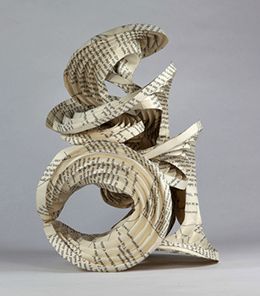 | | |
Destructors I, 2013, elephant hide paper; Erik Demaine and Martin Demaine. Canadian Bookbinders and Book Artists Guild Collection
| |
What do origami and math have in common? Find out when MIT mathematicians Martin and Erik Demaine discuss how they use geometric structures to create intricate sculptures from folded paper. Mathematically, they continually develop algorithms to fold paper into any shape. Sculpturally, they explore curved creases that, while poorly understood mathematically, have potential applications in robotics and manufacturing. Their sculptures can be found in the permanent collections of the Museum of Modern Art, New York, and the Smithsonian American Art Museum, Washington, D.C. The lecture, Sunday, January 25, at 7 p.m. is free, but advance reservations are required. Check here for the latest information.
Sponsored by the Reva Taubman Stocker Fund
Back to top |
|
|
|
|
|
Detroit Institute of Arts
5200 Woodward Avenue
Detroit, Michigan 48202
www.dia.org
313.833.7900
Comments or questions about the newsletter? Please contact us: comments@dia.org
ADMISSION
$8 adults, $6 seniors, $4 children
The museum is free for members and residents of Wayne, Oakland, and Macomb Counties
Contact the Membership HelpLine at
313.833.7971 or membership@dia.org
For group sales (15 or more) contact 313.833.1292 or dia.org/grouptours
|
HOURS
Museum
Mon CLOSED
Tue, Wed, Thur 9 a.m.-4 p.m.
Fri 9 a.m.-10 p.m.
Sat, Sun 10 a.m.-5 p.m.
PARKING
Valet parking is $10 per car and available at the Woodward entrance Friday through Sunday during museum hours.
Lighted, secure self-parking is available in the museum parking lot, between John R and Brush behind the museum, for $7.
|
CaféDIA
313.833.7966
Tue, Wed, Thur 11:30 a.m.-2:30 p.m.
Fri 11 a.m.-2:30 p.m., 4-9 p.m.
Sat, Sun 11 a.m.-3 p.m.
Kresge Court
Tue, Wed, Thur 9 a.m.-3:30 p.m.
Fri 9 a.m.-9:30 p.m.
Sat., Sun 10 a.m.-4:30 p.m.
Museum Shop
313.833.7944 or museumshop@dia.org
Open during museum hours or online at diashop.org
|
|
|
|
|
|